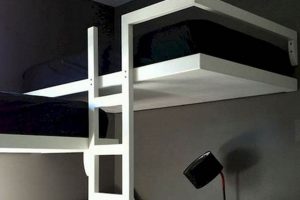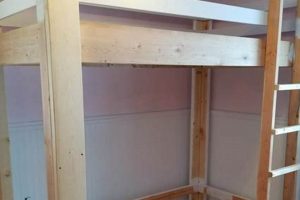Elevating beds through self-constructed supports provides increased under-bed storage and potentially improves accessibility. These homemade solutions range from simple wooden blocks to more elaborate constructions incorporating fasteners and stabilizing elements. A common application involves individuals seeking to maximize space in smaller living quarters or those requiring a higher bed for medical or comfort reasons.
The practice of raising furniture is historically rooted in functionality and adaptation to available resources. Increased storage capacity is a primary driver, offering practical solutions for organizing belongings in limited spaces. Furthermore, altering bed height can address ergonomic considerations, easing the transition for individuals with mobility constraints. The construction of these elevation devices allows for customization, accommodating specific needs and aesthetic preferences within a dwelling.
Considerations for safely and effectively raising a bed include material selection, load-bearing capacity, and stability. This exploration details various construction methods, material choices, and safety precautions applicable to creating reliable and aesthetically suitable bed elevation solutions.
Construction Considerations for Bed Elevation
The effective and safe creation of bed risers necessitates careful planning and execution. The following considerations will aid in the construction process.
Tip 1: Material Selection: Choose dense, durable materials such as hardwood (oak, maple) or high-density plastics. The material’s compressive strength directly impacts load-bearing capacity and overall safety. Avoid using brittle or easily deformable substances.
Tip 2: Load Calculation: Accurately estimate the combined weight of the bed frame, mattress, and occupants. This value is crucial for determining the required dimensions and material strength of the risers. Err on the side of caution by overestimating the load.
Tip 3: Height Determination: Measure the desired final bed height, accounting for mattress thickness and individual ergonomic needs. Avoid excessively raising the bed, as this can compromise stability and increase the risk of falls.
Tip 4: Stable Base: Design the risers with a wide, stable base to prevent tipping. A square or rectangular base is generally more stable than a circular one. Consider incorporating non-slip pads on the bottom surface to increase friction with the floor.
Tip 5: Secure Attachment: If possible, securely attach the risers to the bed frame using screws, bolts, or recessed receptacles. This minimizes the risk of the bed shifting or collapsing. Ensure the fasteners are appropriately sized and rated for the expected load.
Tip 6: Uniform Height: Precisely measure and cut each riser to the same height. Even slight variations can create instability and uneven weight distribution, potentially damaging the bed frame or flooring.
Tip 7: Safety Testing: After installation, thoroughly test the stability of the elevated bed by applying pressure to various points on the frame. Check for any signs of wobbling, creaking, or shifting. Reinforce the risers as needed.
Proper material selection, accurate load calculation, and secure construction are paramount when creating supports for beds. These considerations contribute to a stable and safe elevated sleeping platform.
Following these construction guidelines will promote safety and stability of elevated beds, however, professional assessment should be sought for specific needs.
1. Material Compressive Strength
Material compressive strength, defined as the capacity of a material to withstand axially directed pushing forces, is a paramount consideration in the construction of bed risers. Its significance directly influences the safety and longevity of these self-made supports.
- Load-Bearing Capacity
The compressive strength of the material dictates the maximum weight the riser can safely support without deformation or failure. Exceeding this limit can result in structural compromise, leading to potential accidents. For instance, a riser crafted from softwood with insufficient compressive strength may buckle under the weight of a bed and its occupants, whereas hardwood with superior compressive strength is less prone to such failure.
- Material Selection Criteria
Compressive strength should be a primary criterion when selecting materials. Hardwoods like oak or maple, and certain high-density plastics, are generally preferred due to their high compressive strength ratings. These materials provide a greater safety margin compared to softer woods or low-density polymers, which exhibit lower resistance to compressive forces. The chosen material must align with the calculated load requirements.
- Riser Dimensions and Design
The dimensions and design of the riser interact with the compressive strength of the material. A riser with a small surface area subjected to a high compressive force will experience greater stress than one with a larger surface area. Optimizing the riser’s geometry, such as increasing its cross-sectional area, can distribute the load more evenly and reduce the stress on the material, enhancing its ability to withstand compressive forces.
- Long-Term Durability
Materials with high compressive strength contribute to the long-term durability of bed risers. Over time, materials subjected to constant compressive stress can exhibit creep, a slow and permanent deformation. Materials with greater compressive strength are more resistant to creep, ensuring the risers maintain their structural integrity and functionality over an extended period. This reduces the likelihood of needing frequent replacements or repairs.
The careful consideration of material compressive strength is indispensable for the successful and safe implementation of bed risers. By selecting appropriate materials, optimizing riser design, and accurately calculating load requirements, individuals can construct reliable and durable bed elevation solutions.
2. Load Distribution Mechanics
Load distribution mechanics plays a pivotal role in the design and construction of stable and safe homemade bed risers. Efficient load distribution minimizes stress concentration, ensuring the risers can bear the weight of the bed, mattress, and occupants without structural failure. Understanding these principles is paramount to achieving a reliable elevation system.
- Surface Area and Pressure
The surface area of the riser base directly impacts the pressure exerted on the flooring. A larger surface area distributes the load over a wider region, reducing pressure and preventing damage to the floor. Conversely, a smaller surface area concentrates the load, potentially leading to indentations or cracking, particularly on softer flooring materials. For bed elevation solutions, maximizing the base area relative to the expected load is a beneficial design strategy.
- Centroid Alignment
The centroid, or geometric center, of the riser should align with the load’s center of gravity. Misalignment creates uneven load distribution, placing greater stress on one side of the riser and increasing the risk of tipping or collapse. Precision in placement and ensuring the bed’s weight is evenly distributed across all risers contribute to system stability. Utilizing shims can correct minor imbalances in weight distribution.
- Material Homogeneity and Uniformity
Consistent material properties throughout the riser are essential for uniform load distribution. Variations in density or structural integrity can lead to localized stress concentrations and premature failure. Selecting high-quality materials and ensuring consistent construction techniques promote homogeneity. Layered construction, if employed, must ensure uniform bonding between layers to prevent delamination under load.
- Stress Concentration Mitigation
Sharp corners and abrupt changes in geometry can create stress concentration points within the riser. These points experience disproportionately high stresses under load, increasing the likelihood of cracking or deformation. Rounding edges and incorporating smooth transitions in the riser’s design minimizes stress concentration. Reinforcement strategies, such as internal supports or external bracing, can further mitigate stress at critical points.
Effective application of load distribution principles is essential for the creation of robust and dependable bed risers. By considering surface area, centroid alignment, material homogeneity, and stress concentration, individuals can construct bed elevation solutions that safely and reliably support the intended load. Consistent monitoring of riser condition and periodic load assessment can proactively manage system stability.
3. Attachment Point Security
Attachment point security, regarding self-constructed bed elevation solutions, constitutes a critical safety and stability factor. Securely affixing the risers to the bed frame minimizes movement, prevents accidental dislodgement, and distributes the load effectively. Compromised attachment points jeopardize the structural integrity of the entire elevated bed system.
- Fastener Selection and Compatibility
The selection of appropriate fasteners, such as screws, bolts, or specialized connectors, is paramount. Fasteners must possess adequate shear and tensile strength to withstand the anticipated loads. Compatibility with the bed frame and riser materials is crucial to prevent corrosion or material degradation. Pilot holes, pre-drilling, and proper torque application minimize the risk of stripping threads or weakening the connection. Examples include using lag bolts for wooden frames and metal brackets with bolts for metallic frames. The incorrect fastener can lead to joint failure under stress.
- Recessed Receptacles and Frame Integration
Incorporating recessed receptacles or integrating the risers directly into the bed frame design enhances attachment security. Recessed receptacles provide a secure seating for the bed frame legs, preventing lateral movement. Frame integration, such as interlocking joints or welded connections (where applicable and safe), distributes the load across a larger surface area, reducing stress on individual fasteners. This approach offers superior stability compared to relying solely on surface-mounted fasteners. Beds employing integrated designs exhibit less wobble and a reduced risk of detachment.
- Anti-Slip Measures and Surface Friction
Implementing anti-slip measures, such as rubber pads or textured surfaces, at the attachment points increases friction and prevents slippage. These measures reduce the reliance solely on fasteners for maintaining secure connections, providing an additional layer of protection against movement. Roughing the contact surfaces slightly before joining can enhance adhesion. The effectiveness of these measures depends on the weight of the bed and the material properties of the contacting surfaces. Surface treatments like coatings may further boost friction.
- Periodic Inspection and Maintenance
Regular inspection of the attachment points is essential for identifying and addressing potential issues before they compromise system integrity. Checking for loose fasteners, signs of material fatigue, or corrosion is crucial. Tightening loose connections, replacing damaged fasteners, and reapplying anti-slip treatments maintain the long-term security of the elevated bed system. Neglecting maintenance can lead to gradual degradation of the attachment points and increase the risk of failure over time. Consistent surveillance can prevent accidents.
Secure attachment points are non-negotiable for DIY bed riser applications. The proper selection of fasteners, integration of recessed receptacles, utilization of anti-slip measures, and execution of periodic inspections collectively ensure a stable and reliable elevated bed configuration. The absence of robust attachment strategies undermines the structural integrity, rendering the self-made solution potentially hazardous.
4. Geometric Base Stability
Geometric base stability is a foundational element in the design and construction of self-made bed elevation devices. The shape and dimensions of the riser’s base directly influence its resistance to tipping and overall stability under load. This principle is critical for ensuring a safe and functional elevated sleeping platform.
- Base Area and Overturning Moment
The area of the riser’s base directly correlates with its resistance to overturning. A wider base increases the distance required to generate a tipping force or overturning moment. A larger base provides a greater lever arm against tipping, enhancing stability. For example, a square or rectangular base offers superior stability compared to a circular base of equal surface area, due to its increased width in multiple directions. Applying this principle to bed risers results in a safer design, especially in environments where accidental bumps or shifts are possible.
- Center of Gravity and Support Polygon
The location of the bed’s center of gravity relative to the support polygon formed by the riser bases dictates stability. The support polygon is the area created by connecting the outermost points of the riser bases. If the center of gravity falls outside the support polygon, the bed will be unstable and prone to tipping. Lowering the bed’s center of gravity or widening the support polygon through strategic riser placement increases stability. In self-made bed elevation, careful consideration of weight distribution is paramount to avoid instability issues.
- Shape and Load Distribution
The shape of the riser base influences load distribution across the floor. A uniformly shaped base, such as a square or rectangle, provides even weight distribution, minimizing stress concentration on any single point. Irregular shapes can create uneven load distribution, potentially damaging flooring or compromising riser integrity. The shape also influences how force is transferred to the underlying surface, with sharp corners creating higher stress points. DIY bed risers must consider shape and material choices in tandem to assure balanced support.
- Material Properties and Deformation
The material properties of the base, particularly its resistance to compression and deformation, contribute to overall geometric stability. Materials with high compressive strength maintain their shape under load, preventing the base from deforming and reducing the risk of instability. Softer materials may compress or deform over time, altering the geometry of the base and compromising stability. In constructing bed risers, selecting materials suitable for long-term load-bearing is critical for preserving the initial geometric stability.
The principles of geometric base stability are integral to the safe and effective design of bed elevation solutions. Understanding these principles and their influence on load distribution, resistance to overturning, and material deformation enables individuals to construct reliable and stable bed risers. Careful consideration of base area, center of gravity, shape, and material properties contributes to a secure elevated bed system.
5. Height Adjustment Customization
Height adjustment customization represents a significant advantage of self-constructed bed elevation solutions, enabling individuals to tailor bed height to specific needs and preferences. This adaptability contrasts with standardized, commercially available options, offering a nuanced approach to ergonomic considerations and functional requirements.
- Ergonomic Optimization
Height adjustment customization facilitates the optimization of bed height for individual ergonomic needs. The appropriate bed height minimizes strain during ingress and egress, particularly beneficial for individuals with mobility limitations or musculoskeletal conditions. Precise height adjustments can be achieved through modular riser designs or the use of shims, allowing for fine-tuning to achieve optimal comfort and reduce physical stress. Conversely, fixed-height bed frames may exacerbate existing discomfort or create new ergonomic challenges.
- Storage Maximization
The ability to customize bed height directly influences the amount of under-bed storage space available. Height adjustments can accommodate larger storage containers or facilitate easier access to stored items. This is especially relevant in smaller living spaces where maximizing storage capacity is paramount. Incremental height adjustments enable efficient utilization of under-bed space without compromising accessibility. Pre-fabricated risers often offer limited height options, potentially sacrificing storage efficiency.
- Accessibility Modifications
Height adjustment customization addresses specific accessibility needs for individuals with disabilities. Raising bed height can facilitate transfers to and from wheelchairs or other mobility aids. Specific height requirements are dictated by the user’s individual needs and the dimensions of their mobility equipment. Self-constructed risers offer the flexibility to achieve precise height adjustments necessary for seamless and safe transfers. Compliance with accessibility standards may necessitate custom solutions not readily available in commercial products.
- Aesthetic Integration
The ability to fine-tune bed height allows its visual integration within a room. Varying the elevation of the bed alters proportions within the space, impacting its style. Further, selecting materials can make an elevated bed stand out or blend seamlessly, based on its height. In this way, individuals customize not just what the bed can do, but the look of the room.
Height adjustment customization, as an inherent feature of self-constructed bed risers, addresses a spectrum of ergonomic, functional, and accessibility requirements not always met by standardized solutions. The ability to precisely tailor bed height offers substantial benefits in terms of comfort, storage optimization, and accessibility accommodations, solidifying the value proposition of customized bed elevation strategies.
Frequently Asked Questions
The following section addresses common inquiries and concerns related to the design, construction, and implementation of self-made bed elevation solutions.
Question 1: What constitutes a structurally sound material for constructing bed risers?
Durable, high-density materials such as hardwood (oak, maple) or high-density plastics are recommended. The compressive strength of the chosen material directly impacts the riser’s load-bearing capacity and overall safety. Softwoods and low-density polymers are generally unsuitable.
Question 2: How is the appropriate riser height determined?
Riser height should be determined based on individual ergonomic needs, desired under-bed storage space, and accessibility requirements. Measure the existing bed height and add the desired elevation, accounting for mattress thickness. Avoid excessive elevation, which can compromise stability.
Question 3: Is securing the risers to the bed frame necessary?
Securing the risers to the bed frame is highly recommended to prevent movement and enhance stability. Fasteners such as screws or bolts, or recessed receptacles, can be used to create a secure connection. The choice of fastener should be compatible with the bed frame and riser materials.
Question 4: How is the risk of tipping or instability mitigated?
A wide, stable base is crucial for preventing tipping. Ensure the base area is sufficiently large relative to the bed’s weight. Distribute the load evenly across all risers. Consider incorporating non-slip pads on the bottom surface to increase friction with the floor.
Question 5: What maintenance is required for self-made bed risers?
Regularly inspect the risers for signs of damage, wear, or loose connections. Tighten any loose fasteners and replace damaged components. Monitor the risers for evidence of deformation or compression. Periodic inspections are essential for maintaining system integrity.
Question 6: Are there any safety precautions to consider during construction and installation?
Accurately calculate the load-bearing capacity of the risers. Use appropriate safety equipment, such as eye protection and gloves, during construction. Ensure the risers are uniformly sized and level. Thoroughly test the stability of the elevated bed after installation.
These FAQs serve as a starting point for addressing common concerns related to DIY bed elevation. Always prioritize safety and consult with a professional if uncertainties persist.
Transitioning to the subsequent section, insights will be provided into alternative bed elevation methods.
Conclusion
This exposition has presented a detailed examination of diy bed risers, underscoring their potential for space optimization, ergonomic enhancement, and accessibility modification. The successful implementation of such projects hinges upon meticulous planning, prudent material selection, and rigorous adherence to safety protocols. Considerations of compressive strength, load distribution, attachment security, geometric base stability, and height adjustment customization are paramount to achieving a stable and reliable elevated bed system.
While the construction of diy bed risers offers a customizable and cost-effective solution, it is imperative to recognize the inherent responsibilities associated with such endeavors. Proper execution is non-negotiable, as structural failure can result in injury or property damage. Individuals should carefully assess their capabilities and seek professional guidance when necessary, ensuring that safety remains the foremost priority in the pursuit of personalized bed elevation solutions.



![DIY Truck Bed Rack: Build Your Own Bed Rack [Plans] The DIY Hub: Creative Crafts, Repairs & Life Hacks DIY Truck Bed Rack: Build Your Own Bed Rack [Plans] | The DIY Hub: Creative Crafts, Repairs & Life Hacks](https://craftingdiycenter.com/wp-content/uploads/2025/07/th-2452-300x200.jpg)



